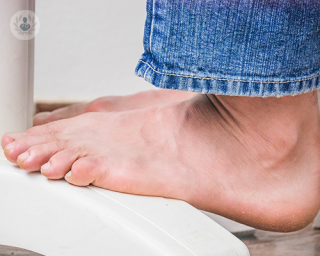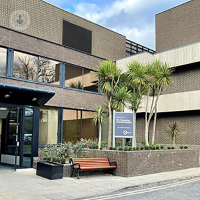What is diabetic foot?
Diabetes can affect the feet in a number of ways and diabetic foot is said to occur when the foot displays symptoms of a condition arising from diabetes or complications of diabetes. This can include a range of problems, such as ulcers and infections.

What are the symptoms?
Leg ulcers, infection and sores are common complications. In severe cases, sepsis can lead to amputation of the foot. Problems like athlete’s foot, calluses, fungal nail infection, corns, blisters, bunions, dry skin and ingrown toenails can pose a more serious problem for those with diabetes.
Blisters and other foot injuries will typically heal slowly and breaks in the skin or discharge from a wound, changes to the colouration of the skin, swelling around an injury and/or an ulcer all need immediate attention for those with diabetes.
What causes or what produces diabetic foot?
Damage to nerves and blood vessels from high blood sugar over time can cause loss of feeling (neuropathy) in the feet and can impair the body's healing ability due to reduced blood flow. As a result, damage to the foot may go unnoticed and take longer to heal, leading to ulcers and infections.
How can diabetic foot be prevented?
For diabetics, it is firstly very important to try and keep blood sugar levels under control to prevent damage to the nerves and blood vessels. As normal foot problems are more problematic, it is recommended that:
- feet are checked regularly
- toe nails are trimmed regularly
- shoes and socks are worn to protect the feet
- good circulation is maintained
- feet are washed regularly.
In addition, people at high risk of getting ulcers may undergo screening. Good patient education can also help prevent problems. It is also recommended that the patient stops smoking as this also worsens circulation. Therapeutic shoes can also help to protect the feet.
What is the treatment of diabetic foot?
The specific treatment will depend on individual circumstances and the type of foot problem being dealt with.
Where diabetic foot ulcers are present, it is important to avoid making the ulcer worse and to prevent it from becoming infected. Taking pressure off the feet as much as possible helps to prevent the ulcer worsening and allows time for it to heal. Diabetic shoes, shoe inserts, compression wraps etc. can also be used.
If the ulcer is infected, it will need to be treated straight away. The treatment will depend on the type and severity of the infection and can include medication like antibiotics or topical treatments.
In more severe cases, surgical treatment may be necessary. This can include the removal of foot deformities or even amputation in the case of life threatening infections.
What specialists treat diabetic foot?
Diabetic foot often requires a multidisciplinary team approach to treatment, depending on the severity of the case. Therefore, diabetic foot may be treated by a general physician, endocrinologist, vascular surgeon, a specialist in internal medicine, surgeon and physical therapist.
06-09-2017 06-06-2023Diabetic foot
Ms Sophie Renton - Vascular surgery
Created on: 06-09-2017
Updated on: 06-06-2023
Edited by: Jay Staniland
What is diabetic foot?
Diabetes can affect the feet in a number of ways and diabetic foot is said to occur when the foot displays symptoms of a condition arising from diabetes or complications of diabetes. This can include a range of problems, such as ulcers and infections.

What are the symptoms?
Leg ulcers, infection and sores are common complications. In severe cases, sepsis can lead to amputation of the foot. Problems like athlete’s foot, calluses, fungal nail infection, corns, blisters, bunions, dry skin and ingrown toenails can pose a more serious problem for those with diabetes.
Blisters and other foot injuries will typically heal slowly and breaks in the skin or discharge from a wound, changes to the colouration of the skin, swelling around an injury and/or an ulcer all need immediate attention for those with diabetes.
What causes or what produces diabetic foot?
Damage to nerves and blood vessels from high blood sugar over time can cause loss of feeling (neuropathy) in the feet and can impair the body's healing ability due to reduced blood flow. As a result, damage to the foot may go unnoticed and take longer to heal, leading to ulcers and infections.
How can diabetic foot be prevented?
For diabetics, it is firstly very important to try and keep blood sugar levels under control to prevent damage to the nerves and blood vessels. As normal foot problems are more problematic, it is recommended that:
- feet are checked regularly
- toe nails are trimmed regularly
- shoes and socks are worn to protect the feet
- good circulation is maintained
- feet are washed regularly.
In addition, people at high risk of getting ulcers may undergo screening. Good patient education can also help prevent problems. It is also recommended that the patient stops smoking as this also worsens circulation. Therapeutic shoes can also help to protect the feet.
What is the treatment of diabetic foot?
The specific treatment will depend on individual circumstances and the type of foot problem being dealt with.
Where diabetic foot ulcers are present, it is important to avoid making the ulcer worse and to prevent it from becoming infected. Taking pressure off the feet as much as possible helps to prevent the ulcer worsening and allows time for it to heal. Diabetic shoes, shoe inserts, compression wraps etc. can also be used.
If the ulcer is infected, it will need to be treated straight away. The treatment will depend on the type and severity of the infection and can include medication like antibiotics or topical treatments.
In more severe cases, surgical treatment may be necessary. This can include the removal of foot deformities or even amputation in the case of life threatening infections.
What specialists treat diabetic foot?
Diabetic foot often requires a multidisciplinary team approach to treatment, depending on the severity of the case. Therefore, diabetic foot may be treated by a general physician, endocrinologist, vascular surgeon, a specialist in internal medicine, surgeon and physical therapist.


Cramp-like pain in the legs? What you should know about peripheral vascular disease
By Mr Mohamed Abdelhamid
2024-11-19
Peripheral vascular disease is a condition where blocked arteries restrict blood flow, causing cramp-like pain in the legs and, in some patients, pain in the feet while resting. In this article highly esteemed consultant vascular and endovascular surgeon Mr Mohamed Abdelhamid gives expert insight on the condition's symptoms and diagnosis as well as treatment options. See more


Diabetic foot infection symptoms and treatment
By Mr Mohamed Abdelhamid
2024-11-19
Diabetic foot infection is a serious complication of diabetes that requires prompt and effective treatment. Here, Mr Mohamed Abdelhamid, renowned consultant vascular and endovascular surgeon, provides an expert insight. See more


How does diabetes affect your feet?
By Mr S. Tawqeer Rashid
2024-11-15
You might have heard of the phrase “diabetic foot” – but what does it actually mean? Why does diabetes affect the feet in particular? We spoke to consultant vascular surgeon Mr S Tawqeer Rashid, a specialist in diabetic foot disease. See more


Insights into diabetic foot management
By Mr S. Tawqeer Rashid
2024-11-04
In his latest online article, Mr S. Tawqeer Rashid gives us his insights into diabetic foot. He talks about the most effective surgical options for managing a severe diabetic foot ulcer, what the multidisciplinary approach to enhance the treatment would be and the key consideration in selecting between conservative therapy and a surgical intervention. See more
Experts in Diabetic foot
-
Ms Sophie Renton
Vascular surgeryExpert in:
- Diabetic foot
- Venous ulcer
- Peripheral arterial disease
- Varicose veins
- Carotid endarterectomy
- Varicose veins surgery
-
Mr Gary Maytham
Vascular surgeryExpert in:
- Varicose veins
- Peripheral arterial disease
- Aortic aneurysms
- Carotid artery disease
- Diabetic foot
- Lymphoedema
-
Mr S. Tawqeer Rashid
Vascular surgeryExpert in:
- Varicose veins
- Leg ulcers
- Diabetic foot
- Carotid artery disease
- Aortic aneurysms
- Peripheral arterial disease
-
Dr Prash Vas
Endocrinology, diabetes & metabolismExpert in:
- Diabetic foot
- Diabetes
- Diabetic neuropathy (diabetes pain)
- Diabetic nephropathy
- Hypothyroidism
- Pre-diabetes
-
Mr Prakash Saha
Vascular surgeryExpert in:
- Varicose veins
- Deep vein thrombosis (DVT)
- Leg ulcers
- May-Thurner syndrome
- Aortic aneurysms
- Diabetic foot
- See all

UK Vein Clinic
UK Vein Clinic
150 Harley St
No existe teléfono en el centro.
By using the telephone number provided by TOP DOCTORS, you automatically agree to let us use your phone number for statistical and commercial purposes. For further information, read our Privacy Policy
Top Doctors

The Harborne Hospital - part of HCA Healthcare
The Harborne Hospital - part of HCA Healthcare
Mindelsohn Way, B15 2FQ
No existe teléfono en el centro.
By using the telephone number provided by TOP DOCTORS, you automatically agree to let us use your phone number for statistical and commercial purposes. For further information, read our Privacy Policy
Top Doctors

The Clementine Churchill Hospital - part of Circle Health Group
The Clementine Churchill Hospital - part of Circle Health Group
Sudbury Hill, Harrow HA1 3RX
No existe teléfono en el centro.
By using the telephone number provided by TOP DOCTORS, you automatically agree to let us use your phone number for statistical and commercial purposes. For further information, read our Privacy Policy
Top Doctors
-
UK Vein Clinic
150 Harley St, W1G Marylebone LondonExpert in:
- Radiofrequency ablation (RFA)
- Thread veins
- Endovenous laser treatment (EVLA)
- Foam sclerotherapy
- Varicose veins
-
The Harborne Hospital - part of HCA Healthcare
Mindelsohn Way, B15 2FQ, BirminghamExpert in:
- Digestive
- Cancer
- Orthopaedic surgery
- Thoracic Surgery
- Diagnostic Imaging
- Obstetrics and Gynaecology
-
The Clementine Churchill Hospital - part of Circle Health Group
Sudbury Hill, Harrow HA1 3RX, West LondonExpert in:
- Abdominal ultrasound
- Abdominoplasty
- Acne
- Allergies bronchopulmonary
- Allergies nose and ears
- Allergy Dermatitis
- Most viewed diseases, medical tests, and treatments
- Hormone therapy
- Autoimmune diseases
- Joint pain
- Nutrition
- Lumbar herniated disc
- Abdominal pain
- Endovenous laser treatment (EVLA)
- Spinal surgery
- Minimal access surgery (keyhole surgery)
- Vaginal cytology






